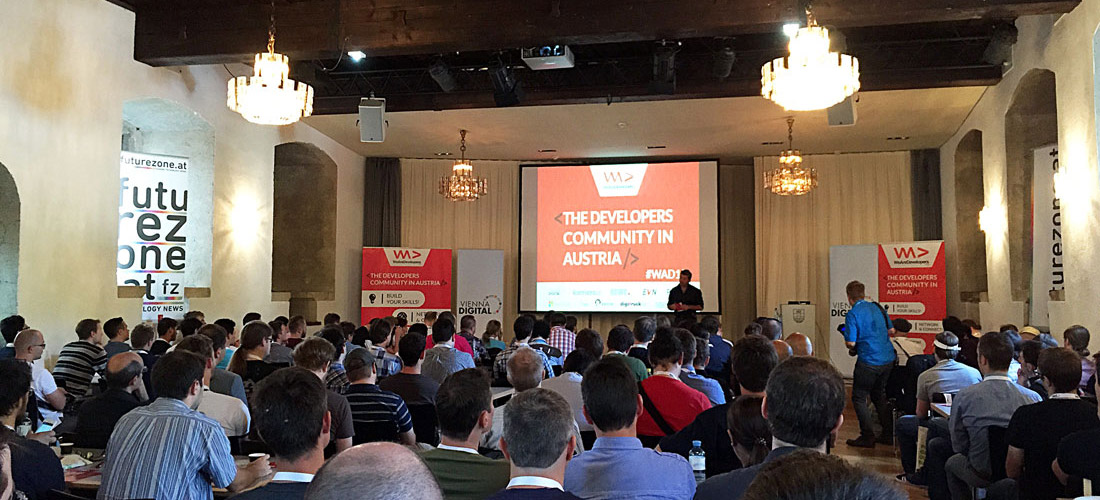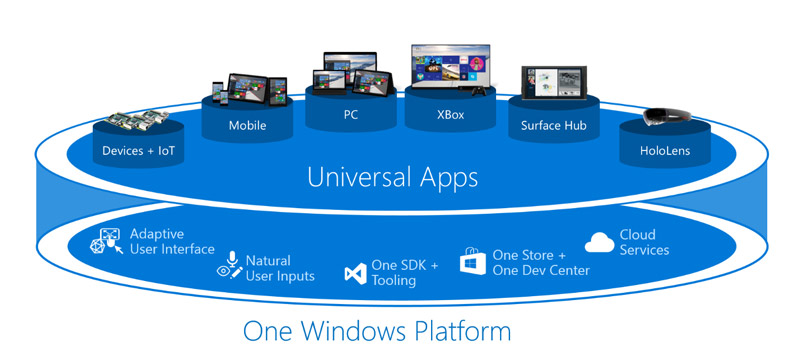
13 Juni Technology Trends of Tomorrow – IoT & LBS – WeAreDevelopers (Part 1)
The WeAreDevelopers.org conference that took place on 11th June 2015 at Burg Perchtoldsdorf was an awesome event! Leading experts were sharing their knowledge in a series of keynotes and round-table discussions. The event was connecting innovative organizations & startups, inspiring entrepreneurs and developers. To keep you up-to-date with the latest trends, technologies and best practices in web and mobile development, we summarized the highlights of the conference in a series of two articles. This first article deals with the topics Internet of Things, Location Based Technology, iBeacons and Windows Universal Platform.
Internet of Things
It all started with a keynote by Daniel Kalbeck, CEO at kalbeck.media and IoT (Internet of Things) pioneer. When it comes to IoT the main challenge is transforming features into a desirable product – it’s about convenience and fun, not just features. The user experience (UX) has to simplify and tell a story. Kalbeck stated that IoT is „app development on steroids“ because it’s very close to the user. As an example for „contextualization“ he brought the example of a counter in a coffee machine that is combined with an issue tracking system to give statistics about the development process and wether deadlines can be met or not. He also claimed that „it’s not about big data, it’s about little data“. Personalization (skinning, custom dashboards) and convenience (setup, detection, security, unified frontends) are very important concepts in the field of IoT as well.
Location Based Services and iBeacons
Thomas Hinterleitner of LOC-Place.com talked about new possibilities in the area of Location Based Services (LBS). He said that retailers currently have a „black hole“ that yet needs to be filled – they don’t know what people are doing in their stores. Because of this there is a paradigm shift going on – the focus moves from check-OUT to check-IN. Just two days before the conference Facebook announced what he described as a revolution in this field – they will offer beacons for free for every business! Starting in the USA, we don’t know yet if and when the social network giant will offer the same in Europe. The speaker also pointed back to the year 2008, when Google announced it’s „mobile first“ strategy at the MWC. The new technologies are all about bridging the virtual-real world gap, the Location Based Marketing Association (LBMA) even states that „location is the NEW cookie“.
![]()
A Beacon is literally a lighthouse for customers in the real world. Beacons as well as geo fences can invoke apps on iOS and Android for example. Apple is even providing a physical app store that is location-context aware. Google goes even further with it’s experimental Physical Web project that is about enabling interaction when native apps just aren’t practical. Another technology to watch is LTE Direct, a common discovery platform for the future.
Cornelius Rabsch, CTO and founder of Beaconinside, dived further into the exciting world of iBeacons. They started to appear back in 2010 when the Bluetooth 4.0 (Bluetooth LE, BLE) specification came out. BLE Beacons work with ultra-low power consumption. One drawback is that you still need a native app to work with beacons, so it doesn’t work for mobile (HTML5) web apps. So what is an iBeacon? Basically it’s a small, passive and simple device that is just broadcasting and permanently advertising it’s identifier (ID). The range of a beacon can usually be 30 to 50 meters. Beacons are just one of many technologies for getting the user’s location, others include GPS, WiFi, NFC and cellular. The iBeacon technology became available with iOS 7 in September 2013, and can be used on 80% of all iPhones out there. But iBeacons don’t operate on their own, they need infrastructure. iBeacons don’t deliver content, but in the future so called UriBeacons might broadcast more information than just their Proximity UUID, in step towards making the Internet of Things as easy to use as the World Wide Web. Android supports Bluetooth LE scanning and thus beacons since Android 4.3 Lollipop, even though the iBeacon standard is Apple-only. We’ll definitely see a lot of new technologies popping up in in this field, including security layers and remote management for beacons.
Universal Windows Platform
Microsoft claims to be back and to be more attractive to developers than ever. This might be true because with Windows 10 and the Universal Windows Platform it will be possible to write one application for all devices. This will range from small wearables/devices, phones, tablets, PC, XBox up to TVs with a huge screen size. There will also be a Windows Store for Business and Microsoft aims to have 1 billion devices running Windows 10 in two years. The six device platform will feature one single API surface and there will also be bridges from iOS, Android and web to Windows 10. This is a really interesting announcement for us app developers!

That’s it for the first part. We at creative workline GmbH are incredibly excited about these new IoT and location-based technologies and can’t wait to integrate them into apps for Android, iOS and the web and our products. Are you working on something in this field as well or have an idea that should be realized? Let us know!
Update: Part two of this article can be found here.



Development Process, Team and Technology as Success Factors - WeAreDevelopers (Part 2) - App Entwicklung in Wien - creative workline GmbH
Veröffentlicht um 15:17h, 17 Juni[…] In the second article of this series we continue to sum up the most interesting talks of the WeAreDevelopers conference that took place on 11th June 2015 at Burg Perchtoldsorf near Vienna. Part one can be found here. […]